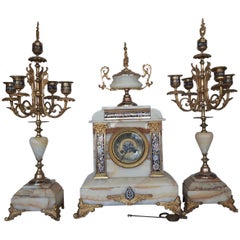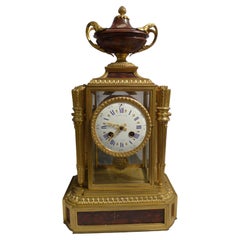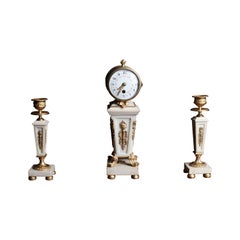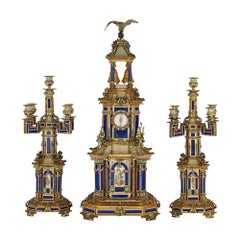Late 19th Century Clocks
to
87
816
420
2,832
1,901
393
567
714
467
130
55
119
151
44
106
149
168
120
43
105
75
49
38
27
17
13
6
4
3
2
2
1
1
637
375
218
212
181
480
310
725
569
62
52
33
Height
to
Width
to
816
816
816
13
11
9
8
7
Period: Late 19th Century
19th Century French Champlevé Enamel and Marble Clock Set
By Napoléon III
Located in London, GB
Three-piece marble and bronze Champlevé enamel clock garniture set, comprising of a central clock and a pair of candelabra. The clock is set on a white marble base on a rectangular p...
Category
French Other Antique Late 19th Century Clocks
Materials
Bronze
French rouge marble and ormolu four glass clock signed Raingo Freres
Located in London, GB
A good antique French ormolu and rouge marble four glass clock by the eminent makers Raingo Freres. The clock with original ormolu is surmounted by an...
Category
French Antique Late 19th Century Clocks
Materials
Marble, Ormolu
Late Victorian White Marble and Bone Garniture
Located in Norwich, GB
Late Victorian white marble and bone miniature garniture.
The French drum movement with platform escapement supported by a white marble base in the form...
Category
French Other Antique Late 19th Century Clocks
Materials
Marble
Impressive Antique Austrian Champlevé Enamel, Silver-Gilt and Lapis Lazuli Clock
Located in London, GB
Impressive antique Austrian champlevé enamel, silver-gilt and lapis lazuli clock set
Austrian, Late 19th century
Clock: Height 91cm, width 37cm, depth 37cm
Candelabra: Height 64cm, width 24cm, depth 24cm
Clock case: Height 97cm, width 44cm, depth 41cm
Candelabra case: 67cm, width 27cm, depth 27cm
Crafted in Austria in the late 19th century, this magnificent three-piece clock set was most likely gifted to the Imperial Russian family by the Austro-Hungarian Royal family. Its design is inspired by various cultures and styles, whilst its high quality celebrates some of the best craftsmen of the late 19th century.
Of a tiered pagoda shape, the clock is surmounted by an eagle, its wings spread wide landing atop a vibrant lapis lazuli ball. The eagle is most likely a reference to Turul, a mythological animal which is a symbol of Hungary. This bird of prey is also a popular feature within Turkish traditions.
Within a canopy, supported on four sturdy lapis lazuli pillars two prominent silver-gilt bells are hanging. These are carved with various motifs such as acanthus leaf design and connect to the clock mechanism below. The bells ring informing its users of the time.
All four sides of the piece are inset with a clock, an unusual feature on an object of this type and a testament to its highest quality. The inclusion of clocks on all sides signifies that the antique is aimed to be a centrepiece, admired from all sides. The dial is decorated using the champlevé enamelling technique, whereby ‘parcels’ are carved into the silver gilt and into which enamel is poured. The 12 numbers are coloured in black with a gold outline and are surrounded by a white circular background making them stand out and easy to read. The hour clock dial is cast in the form of a sun, while the minute hand is represented as the moon. The two motifs symbolise one’s bright and gloomy sides of existence.
The four corners around the clocks are mounted with three-dimensional female figures dressed in traditional garments from around the world. For example, one figure is dressed in typical Turkish clothing...
Category
Austrian Antique Late 19th Century Clocks
Materials
Lapis Lazuli, Silver, Bronze, Enamel



